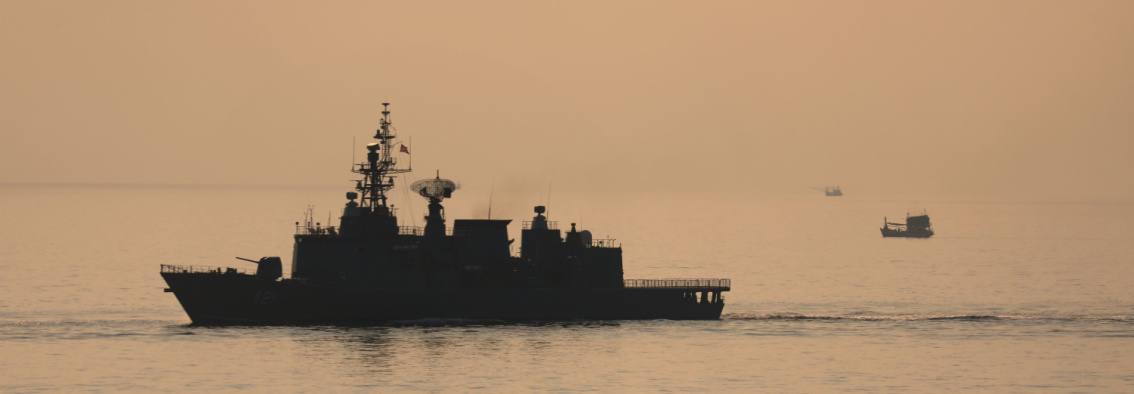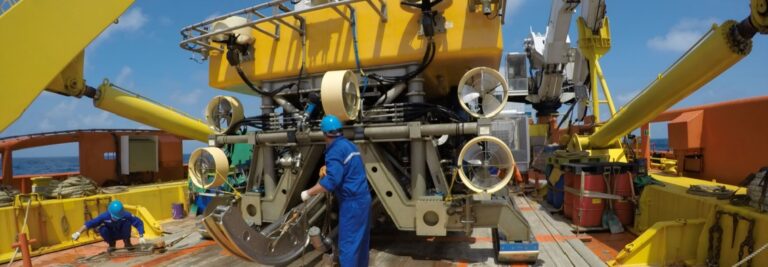On April 1-2, the People’s Liberation Army (PLA) conducted a two-day operation it dubbed Strait Thunder-2025A (海峽雷霆-2025A). This was the first large-scale PLA exercise of 2025 around Taiwan, and followed the “Joint Sword-2024” (聯合利劍-2024A) exercises conducted in May and October 2024 (see previous analysis here and here), as well as unnamed, large scale naval maneuvers in December 2024. This exercise appeared to continue the Joint Sword emphasis on practicing naval blockading maneuvers—while adding the provocative element of conducting simulated strikes against Taiwan’s energy infrastructure and port facilities. The exercise was also accompanied by an escalation in the propaganda rhetoric directed against Taiwan’s political leadership—and President Lai Ching-te (賴清德) in particular.
Exercise Overview
According to spokesman Senior Colonel Shi Yi (施毅) of the PLA Eastern Theater Command, Strait Thunder-2025A mainly focused on joint-force capabilities in “training subjects [such] as identification and verification, warning and expulsion, and interception and detention, in a bid to test the troops’ capabilities in regional control, joint blockade, and precision strike.” PLA forces operated primarily in the middle and southern portions of the Taiwan Strait but did send some ships, including coast guard vessels, outside the First Island Chain.
The exercises themselves focused on evaluating the PLA’s ability to conduct joint operations both inside and outside the First Island Chain. Specifically, the PLA focused on ship-aircraft coordination and establishing regional air superiority—a critical first step in an amphibious invasion. As part of this the PLA simulated strikes on defense infrastructure like command centers, arsenals, air defense command posts, air traffic control centers, special forces headquarters, and specific locations like the Hengshan Wartime Command Post (衡山指揮所). There were also simulated strikes conducted against multiple energy infrastructure targets (see further below). In locations in the middle and southern areas of the Taiwan Strait the PLA-Navy (PLAN) practiced blockading strategic supply routes and energy corridors.
Operations By Service Branch
PLA Ground Force (PLAGF)
The PLA deployed the 72nd Army Artillery Brigade to undisclosed locations in Fujian and Zhejiang Provinces, where it conducted 50 kilometer strikes on eight simulated targets—including one that modeled Taiwan’s Yongan liquified natural gas (LNG) terminal (永安液化天然氣廠) in Kaohsiung. Yongan terminal is the largest LNG terminal in Taiwan and imports over 11 million tons of natural gas annually.
The PLA tested two PHL-191 Multiple Launch Rocket Systems (MCRS) firing 300 mm rockets that have an effective range of 70 to 150 kilometers. According to defense analysts, the PHL-191 system is capable of firing 750 mm tactical ballistic missiles that can strike targets up to 500 kilometers away—a range that would allow this system to hit any major target in Taiwan.
PLA Rocket Force (PLARF)
The PLA-Rocket Force (PLARF) supported the PLA 72nd Army Artillery Brigade and deployed the 613th Rocket Brigade of the 61st Missile Base to test its Dong Feng-15B system. However, no actual missile launches were noted during the exercise.
PLA Air Force (PLAAF)
The PLA-Air Force (PLAAF) coordinated closely with the PLA Navy with many of its J-15 fighter aircraft flying under the command of the Shandong carrier group. In exercise sorties they conducted mock air superiority missions and strike operations on both sea and ground targets. PLAAF activity lasted 24 hours beginning at 6:00 AM on April 1 and included 76 aircraft, with 37 sorties crossing the median line. These incursions came from all sides of the island occurring in the northern, central, southwestern, and eastern edges of Taiwan’s air defense identification zone (ADIZ).
According to the PLA’s Eastern Theater Command, several PLAAF brigades participated and deployed fighters, bombers, support assets—and, according to Taiwan’s Ministry of National Defense (MND,國防部), unmanned aerial vehicles (UAVs). Specifically, the PLAAF deployed the following platforms:
- Fighters
- J-15 (carrier-borne)
- J-10 C/S
- J-11 B/BG
- J-16
- JH-7A
- Su-30 MKK
- The H-6K strategic bomber
- The KJ-500 early warning aircraft
- Y-2OU aerial refueling tanker
- Z-9 helicopters (carrier-borne)
PLA Navy (PLAN) and China Coast Guard
Similar to the previous Joint Sword-2024 exercises, the PLAN incorporated the China Coast Guard in its blockade operation. While the Shandong carrier group operated to Taiwan’s east / southeast, the PLAN also deployed other ships—including coast guard vessels for “law-enforcement patrols”—up and down the Taiwan Strait, reaching outside the First Island Chain. In total, the PLA deployed 15 PLAN ships and four coast guard vessels.
The CNS Shandong aircraft carrier strike group included five total vessels: the carrier CNS Shandong (17), the cruiser CNS Yanan (106), the destroyer CNS Zhanjiang, the frigate CNS Yuncheng (571), and the fast combat support ship CNS Chagan Hu (905). The Shandong carrier is based out of the PLA’s Southern Theater Navy, a fact that only underscores the PLA’s commitment to interoperability. Meanwhile, on Taiwan’s west coast, the PLAN deployed ten ships working closely with four coast guard ships, notably featuring the destroyers CNS Guilin (164) CNS Fuzhou (137).
Of note, according to some press outlets, ships of the Shandong carrier group maneuvered to within 24 nautical miles of Taiwan’s coast—thereby skirting the edge of Taiwan’s contiguous zone (the area just beyond territorial waters, extending from 12-24 nautical miles of the coast). This follows from the declared exercise operating areas of Joint Sword-2025B, which crossed over into Taiwan’s contiguous zone. If such reports are correct, this represents another gradual—but still provocative—move to press PLA forces steadily closer to Taiwan’s coastline.
Political and Propaganda Elements of the Exercise
As is usually the case with prominent PLA exercises around Taiwan, the political warfare elements of the exercise were front-and-center in Strait Thunder-2025A. In both Joint Sword-2024A and Joint Sword-2024B, the stated People’s Republic of China (PRC) reason for the exercise was to serve as displays of resolve in the face of supposed provocations by President Lai (in the former case, the content of his inaugural speech; in the latter case, his October National Day speech). This particular propaganda element was relatively subdued in the December 2024 naval maneuvers; however, it returned to the fore in Strait Thunder-2025A.
The nominal justification for the early April exercise was a March 13 policy speech by Lai, in which he laid out a program of 17 measures to combat CCP espionage and infiltration in Taiwan. PRC outlets seized upon this, as well as an early April trip to Washington, DC by National Security Council Chairman Joseph Wu (吳釗燮), to condemn the “Lai Ching-te authorities’ attempts to solicit U.S. support for ‘Taiwan independence’.” In the lead-up to the exercise, PRC state media released a series of op-eds framing the PLA’s actions as the use of force to prevent war (a starkly different message from the PLA’s bizarre heart-shaped blockade maneuver with the official message, “[our] patrols take the shape of loving you” last October).
Upon commencement of the exercise, the state outlet Global Times declared that the exercise “demonstrate[d] the PLA’s tighter siege on ‘Taiwan independence’ secessionist forces through more stringent measures with thunderous actions.” The PLA also released a video titled “Subdue Demons and Vanquish Evils” (降妖除魔), which depicted the mythical Monkey King leading the PLA onwards to victory.
In the most strident propaganda of all, the PLA Eastern Theater Command—which has primary cognizance over the forces deployed in the vicinity of Taiwan—produced social media material that depicted Lai as a verminous insect (see images below). This echoes PRC propaganda from 2019 that portrayed Hong Kong pro-democracy protestors as “cockroaches” and other vermin—and represents an escalation in the emotive and dehumanizing propaganda imagery directed at Lai in particular, as the personification of “Taiwan independence forces.”

Images: PRC-produced propaganda cartoons, propagated online, which depict Taiwan’s President Lai Ching-te as an insect. In the left image, “Misfortune Hollowing Out Taiwan” (空殼禍臺), Lai is depicted as a dictator, oppressing local figures (former Taiwan People’s Party leader Ke Wen-je and retired general Kao An-kuo, charged respectively with corruption and treason), and instituting “green terror” (綠色恐怖)—while further grasping at corrupt sources of wealth. In the right image, “Smashing the Shell, Destroying Taiwan” (破殼毁臺), Lai is roasted over a flaming Taiwan, surrounded by images of PLA military operations. The depiction of Lai as a poisonous insect represents an escalation in the tone of CCP propaganda directed at Taiwan’s political leadership. (Image source: PLA Eastern Theater Command / CCTV)
Despite the PRC’s official expressions of outrage, PLA forces still waited two and a half weeks after the speech to commence the operation. It is possible that the Chinese Communist Party (CCP, 中國共產黨) waited until CCP General Secretary Xi Jinping concluded his trip to the Boao Forum (博鰲論壇) with international business leaders on March 28. It is also possible that they waited until US Secretary of Defense Pete Hegseth concluded his first trip to Asia on March 31—a trip during which he promised the US military would increase its regional presence to deter China.
Conclusions
Strait Thunder-2025A demonstrated both continuity and incremental change in comparison with similar exercises conducted around Taiwan by the PLA over the past three years. In terms of continuity, it continued maneuvers and training for a potential future blockade operation—as commenced clearly from the 2022 exercise that followed the visit of then-Speaker Nancy Pelosi, and continued through the three Joint Sword exercises of 2023-2024. As always, for the PLA the political warfare element is central to these exercises: including not only the intent to psychologically intimidate Taiwan’s population (and foreign powers that might intervene); but also to place on Taiwan the onus of threatening regional peace, by promoting the narrative that this exercise (almost certainly planned far in advance) represented a necessary reaction to a provocation by “Taiwan independence forces.”
The most noteworthy changes to the exercise were the simulated strikes apparently directed against civilian economic infrastructure targets—a likely necessary step if blockade operations were to escalate into limited kinetic operations, and a clear threat that Taiwan’s energy and economic infrastructure would be in peril in any conflict. Finally, the continued advancement closer to Taiwan’s territory—as evidenced in the reported presence of PLAN ships within the edge of Taiwan’s contiguous zone—appears to mark the most provocative moves yet to squeeze Taiwan’s territorial sovereignty.
The main point: Strait Thunder-2025A appears to be a continuation of last year’s Joint Sword-2024 blockading exercises against Taiwan. However, this iteration focused more heavily on simulating operations against Taiwanese energy infrastructure and ports, particularly LNG terminals, and encroached further into Taiwanese territory than previous exercises. This operation also greatly stepped up its political rhetoric against the Lai administration and other government leaders than previous exercises indicating the PLA will likely continue to increase its aggressive messaging.





